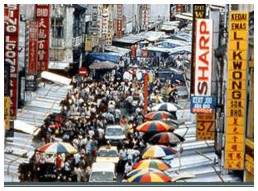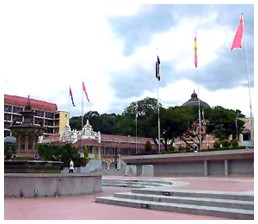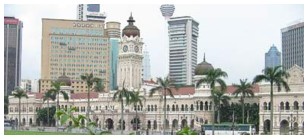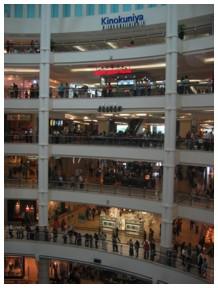|
Kuala Lumpur was established
around 1857 and is therefore one of the most recent Asian capitals. By
that time, 80 Asian tin miners came here to this then "muddy confluence"
(the literal meaning of the word Kuala Lumpur) and as huge quantities of
tin
 were
exported, the city became prosperous and grew at a fast pace. Nowadays ,
there is no mud to be found, everywhere you see high rise buildings, well
organized roads and shops. It is well structured and clean, and looked
much more modern to me than for were
exported, the city became prosperous and grew at a fast pace. Nowadays ,
there is no mud to be found, everywhere you see high rise buildings, well
organized roads and shops. It is well structured and clean, and looked
much more modern to me than for instance
Bangkok. Still, old parts can be found,
and also Chinatown is very vivid. In Petaling street, there is a night
market and the vendors spread their articles out on the street. Almost 30%
of the Malaysian population is Chinese, and many of them have been living there
since the 15th century. Malaysia has about 20 million inhabitants; apart
from the Chinese, about 10% are Indian. The population is very mixed and
colorful, therefore. The Muslim women mostly wear a head scarf, but mainly
a light or colored one, the ends of which are often tucked under their blouse.
The food is often halal, even in the Chinese cuisine, and you do not find
pork in the supermarkets, but on the other hand, you see people on
terraces drinking beer everywhere, and alcohol is freely instance
Bangkok. Still, old parts can be found,
and also Chinatown is very vivid. In Petaling street, there is a night
market and the vendors spread their articles out on the street. Almost 30%
of the Malaysian population is Chinese, and many of them have been living there
since the 15th century. Malaysia has about 20 million inhabitants; apart
from the Chinese, about 10% are Indian. The population is very mixed and
colorful, therefore. The Muslim women mostly wear a head scarf, but mainly
a light or colored one, the ends of which are often tucked under their blouse.
The food is often halal, even in the Chinese cuisine, and you do not find
pork in the supermarkets, but on the other hand, you see people on
terraces drinking beer everywhere, and alcohol is freely
 available. We
often saw the "meter beer", a very large glass column full of the yellow
fluid, and we wondered how the youngsters surrounding it would be able to
drink it all and still walk straight. available. We
often saw the "meter beer", a very large glass column full of the yellow
fluid, and we wondered how the youngsters surrounding it would be able to
drink it all and still walk straight.
Dataran Merdeka (Independence Square) used to be the British Colonial Club
(Selangor Turf Club) where only whites were allowed to booze and play
cricket; that all changed after Malaysia became independent in 1957).
Across the road you will find the Sultan Abdul Samad building, which was
built in 1897 and has an architecture based on several styles. In those
days, it was the center of the British colonial administration, but
nowadays you can find the Supreme and High Courts here.
In this town, you cannot only find buildings, but also many gardens, like
the orchid garden and the hibiscus garden. Close to the lake gardens
stands the Parliament House, obviously in one of the greenest and most
beautiful areas of Kuala Lumpur, or KL as the locals call their city. |
|
In KL you will find two
(actually 3 as Petronas Towers exists of 2 towers) famous towers: the
Petronas Towers and the Menara Tower. The latter is the tallest of Asia,
at least at this moment, with its 421 meters. On top, it houses a Mac
Donald's restaurant. If you want to climb the Petronas towers, you better be well prepared and go
to sleep early the night before: the tickets are free but "sold out"
around eight o'clock in the morning. |
|
 Shopping was for me, poor
spending-derived woman from
Bangladesh, where the most important
shops are full of shelves,
stuffed with the same articles, a main attraction. We made full working
days, covering all the shopping malls, dragging ourselves until 7 in the
evening, in order to miss nothing that was on sale. And that was a huge
job, because Kuala Lumpur is full of shops and shopping malls, full of big
shops with the most fashionable materials as well as an ATM machine on
every corner. Under the Petronas Towers there is a huge shopping mall. And
every shopping mall has restaurants and bars, where you see young people
sharing huse glass chimneys full of beer - that seemed to be the latest
fashion. Shopping was for me, poor
spending-derived woman from
Bangladesh, where the most important
shops are full of shelves,
stuffed with the same articles, a main attraction. We made full working
days, covering all the shopping malls, dragging ourselves until 7 in the
evening, in order to miss nothing that was on sale. And that was a huge
job, because Kuala Lumpur is full of shops and shopping malls, full of big
shops with the most fashionable materials as well as an ATM machine on
every corner. Under the Petronas Towers there is a huge shopping mall. And
every shopping mall has restaurants and bars, where you see young people
sharing huse glass chimneys full of beer - that seemed to be the latest
fashion.
Between the airport and the
city, you will find Putrajaya (named after a Malaysian prime minister
Putra), the just completed administrative center of the federal
government. It is situated in a model garden city and has the most modern
multimedia techniques. Its twin city is not surprisingly called
"Cyberjaya". The cities comprise over 4,000 hectares and are built for
330,000 people, which is quite a lot if you compare it to the population
of KL (approximately 1.8 million).
In KL, of course I could
not resist the Malaysian cookbooks. Food stalls can be found all over the
place. A lot of recipes look Indian, some also Chinese. Roti canai is very
popular for breakfast and dinner, and for lunch the meal is often served
in a banana leaf. The Nonya cuisine (Nonya means woman in the Chinese Hokkien dialect but refers to Malay women of high social standing, married
to Chinese businessmen five centuries ago) is a combination of Malay and Chinese cuisine.
Stir frying in the wok is common and many spices are used, and they are
processed using a pestle and mortar. Fish, cuttlefish and shrimps are part
of many dishes. A popular dish is Laksa, noodles in
spicy coconut soup, with prawn paste (belachan), shrimp, lemon grass and
chicken. Even though laksa means thousand(s), which is supposed to be the
number of ingredients of this soup, there is no need to worry, there are
many ingredients to it, but not so many, and most of them are spices
anyway. The same ingredients you may be able to find in a lot of
Thai recipes. The Malaysians also use
sambal oelek and a lot of lime. Nonya
food has gained world wide popularity and even in Manhattan, you can
frequent the Nonya restaurants. |